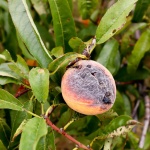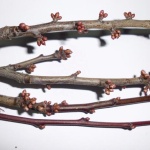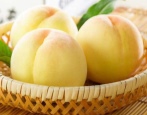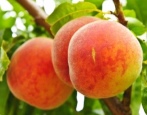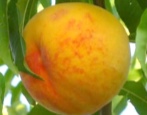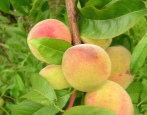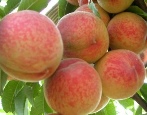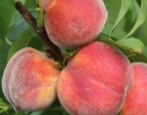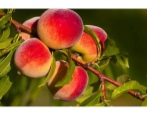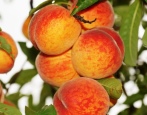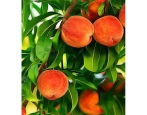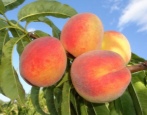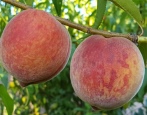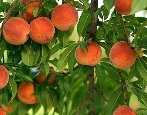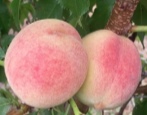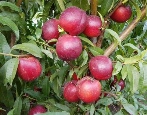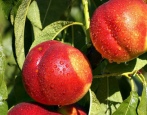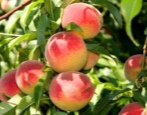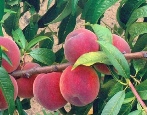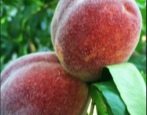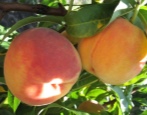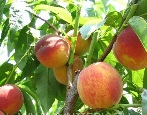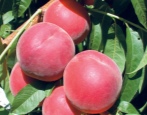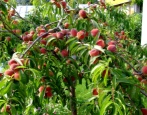
- Authors: USA
- Name synonyms: Cardinal
- Growth type: medium-sized
- Ripening period: early
- Self-fertility: self-fertile
- Appointment: for fresh consumption
- Yield: high
- Early maturity: in the 3rd year after planting the seedling
- Growing regions: any
- Bone size: small
Peach Cardinal is an interesting culture, with delicious and juicy peaches, “was born” far beyond the vastness of our country, which did not prevent it from successfully growing in warm regions of Russia. The qualities of its early maturity and early maturity, resistance to some major diseases typical of peaches, seduced many domestic gardeners.
Breeding history
The Cardinal culture was the result of the fruitful work of American scientists, appeared at the end of the 19th century. Peach trees Cambridge Carmine were taken as a protossort. The originators of the culture were employees of the Nikitsky Botanical Garden, and in 2013 it was entered into the State Register of Ukraine. It is not listed in the State Register of Russia. However, this does not prevent its widespread cultivation on the territory of our country. The main purpose of the Cardinal is to be consumed fresh and in compotes.
Description of the variety
Culture trees are medium-sized (up to 2.5 m) with a rounded crown configuration, somewhat prone to thickening. The southern regions are preferable to the cultivation of this type of peaches, which have an average degree of winter hardiness. The level of self-fertility of the Cardinal is high - it does not require additional pollinating plants. Has a high immune potential against powdery mildew. It is less resistant to curl disease. The rate of early maturity is high.
Productivity in the absence of curl and other diseases is high and regular.
But there are also disadvantages:
low level of keeping quality and portability;
the bones are poorly separated from the consistency;
susceptibility to curliness often leads to the death of young animals if there is no appropriate chemical treatment;
relatively low degree of cold resistance.
Fruit characteristics
Fruits are medium in size, rounded in configuration, slightly flattened on the sides, weighing 140-150 g. The main color of peaches is yellow with carmine stains. Fibrous consistency of the pulp - from yellow to orange color, firm structure, with a significant amount of juice, separating from small bones relatively well.
Taste qualities
By taste, peaches are sweet with an unobtrusive, light sourness.
Ripening and fruiting
The quality of early maturity has good parameters - after planting, excellent yields are quite expected in the 3rd year of growth. The flowering period starts in the last days of April and lasts up to 10 days. The time of annual and stable fruit bearing is the last days of July.
Yield
The crop is high-yielding - the average yield of mature trees reaches 30-35 kg of fruits per tree.
Self-fertility and the need for pollinators
The level of self-fertility of the culture is high.
Growing and care
When selecting Cardinal seedlings, it is important to take into account a number of culture features.
The budding area is usually located 8-10 cm from the neck of the tree, giving it a slight degree of curvature - in this place it grows somewhat to the side. The absence of this procedure indicates a high probability that you are dealing with a seedling, which in the future will not have varietal characteristics.
The height of the selected seedlings should not exceed 1.5 m, and the number of branches should not exceed 4 (their absence is also allowed).
The roots and aerial parts of plants should be moist, without putrefactive signs, growths and deformations. In accordance with GOST, there should be no foliage on the trees.
Taking into account the negative influence of temperature changes and humidity levels, the seedlings should be protected during transportation - their rhizomes should be reliably covered with a damp cotton cloth, and on top of it with a dense bag.
After the seedlings are brought to the place of planting, they are left closed for several days, having previously eliminated small branches that absorb moisture. 2-3 days before the planned planting, the seedlings are unpacked and placed for 24 hours in a container with water at room temperature so that both roots and twigs are in the water. It is advisable to add growth stimulants to the containers.
Experienced specialists cover the bole surfaces with paraffin before planting, which protects trees from pests and scorching sunlight.
The landing site should be located at a certain elevation, be calm, excluding the location of groundwater in relation to the edge of the soil closer than 3 meters.
The culture is extremely light-loving, growing productively in hot and dry climates. Therefore, an excessive degree of moisture can stimulate the occurrence of dangerous diseases. Of the soils, light sandy loam of neutral acidity is preferable. With heavy clay soil, drainage should not be forgotten.
No special efforts are required when growing a crop, it is quite unpretentious, and compliance with standard rules quite allows you to get stable and voluminous yields. Of the other mandatory accents, we indicate:
the distance between seedlings during planting is maintained in the range of 3-4 m;
irrigation in dry season is carried out with a break of 10-14 days;
dressings are made with nitrogen-containing additives, traditional in spring;
the optimal shape of crowns for pruning is a bowl-shaped configuration;
every year, procedures for thinning crowns and shortening young shoots by 10-15 cm should be carried out, that is, minting should be carried out.
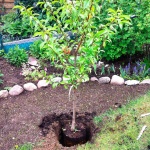
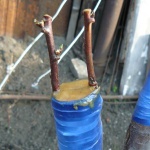
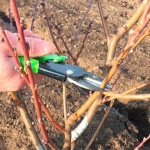
Frost resistance and the need for shelter
The level of winter hardiness of the crop can be called relatively high - the critical temperature drop is –20 degrees.
Disease and pest resistance
Cultures are rarely targeted by malicious attacks. And also it is not very vulnerable to infection of the main diseases of fungal origin, it has a significant immune potential against powdery mildew. To a lesser extent, it is resistant to curly foliage - here you cannot do without the use of chemical protection. We also need professional treatments with fungicides against fungal diseases, which are carried out in 3 stages - before the flowering of the culture, after the flowering period, and also 7 days after the execution of the 2nd procedure.The most popular drugs here are - "Horus", "Skor", "Strobi" and "Quadris".
